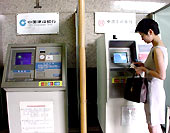
NCR Corp, the world's largest ATM (Automated Teller Machine) manufacturer, has set up a currency data processing center in Beijing to help combat a rising tide of forged currency, according to the company yesterday.
The new centre is designed to specialize in the provision of currency templates that can rapidly be uploaded into ATM networks to ensure financial security. The centre will also help improve the note quality of the renminbi, the local currency.
The establishment of the centre is seen as a very necessary step at the moment, since an increased number of counterfeiting cases have been reported. In addition, there have also been cases reported of criminals trying to deposit fake money through ATMs.
"China is a huge market for cash deposit technologies, and we are dedicated to applying our corporate expertise and resources to more rapidly addressing incidents of a fraudulent nature. Unfortunately, counterfeiting is now a fact of life. It can be addressed by better note security and collaboration when new incidents occur. It is incumbent on the industry to join forces with the central bank to help combat currency fraud," said Keith Au, region product management director, North Asia, NCR Financial Solutions Division.
Although the proportion of forged notes in circulation is relatively small, there was a sharp rise in seizures of counterfeit renminbi last year.
According to the central bank, police netted 550 million yuan (US$66.5 million) of fake money in 2004, a whopping 139.1 per cent year-on-year increase.
The sharp rise in counterfeiting cases can be seen as evidence of the government's efforts to stamp out the crime. But it is also indicative of how widespread forgery has become, and the need for increased urgency to tackle an offence which threatens to undermine the social economy.
According to Au, each time a new note is introduced into circulation by the central bank, the data identifying its authenticity will be stored in a software template that enables ATMs to recognize it as genuine. The centre can rapidly update the latest software for their bank clients to make sure deposited notes are accurately validated and highest levels of customer confidence can be maintained.
Au said that NCR's new centre will work closely with both the central bank and its bank customers to combat fraud by bringing the company's global note recognition technologies and practices to China.
The Chinese market for automated deposit has been growing rapidly in recent years with approximately 6,000 machines offering note acceptance across the country, according to the company.
China's banking system has undergone significant changes now that China has entered the World Trade Organization (WTO), which is leading to a significant opening of this industry to foreign competition.
By the end of 2006, foreign banks will be allowed unfettered access to the Chinese market, which has put significant pressure on the local banks.
The main driver of Chinese banks' adoption of automated deposit is cost-cutting. They are trying to improve efficiency ahead of the liberalization of the financial sector required by China's membership of the WTO.
However, in the future banks will be competing on service more than ever before, and deposit automation is seen as a way of attracting and retaining customers from an increasingly sophisticated client base.
Deposit businesses normally account for 40-60 per cent of total business in a bank branch in China. If deposit transactions can be completed through ATM terminals, banks are expected to also save on labour costs at branches.
Automated deposit can also provide a new opportunity for smaller banks to compete with big State-owned banks.
The extent of deployment of automated deposit varies widely between banks, according to NCR, with some smaller banks having rolled out the technology on a large scale in an attempt to extend their reach, because they will never be able to compete with China's "big four" State-owned banks in terms of the size of their branch networks.
However, according to NCR officials, a technology update is essential to ensure that every ATM transaction is accurate.
(China Daily August 2, 2005)
|

